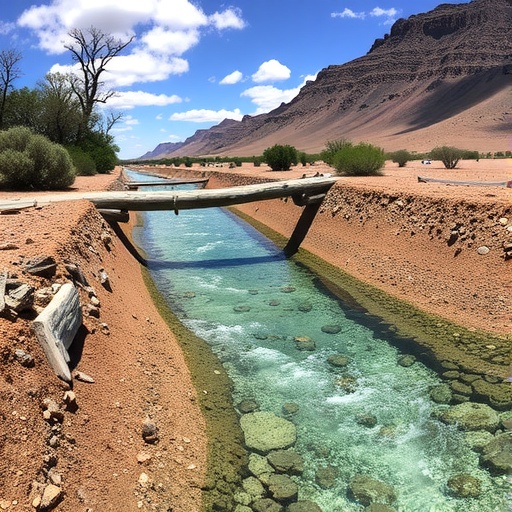In a groundbreaking study recently published in Environmental Earth Sciences, a team of hydrogeologists has unveiled significant insights into the dynamic hydrogeochemical changes occurring within arid groundwater systems. By meticulously analyzing long-term data derived from extensive well-field monitoring, the research provides a transformative understanding of the underlying processes that govern groundwater quality and sustainability in some of the most water-stressed environments on Earth.
Arid and semi-arid regions often grapple with limited freshwater resources, making the preservation and management of groundwater crucial for sustaining local communities and ecosystems. The research spearheaded by Rashid, Sabarathinam, Bhandary, and colleagues delves into hydrogeochemical variations over extended periods, offering invaluable data that reveal the interplay between natural geochemical processes and anthropogenic influences in these delicate aquifers. Such an approach goes beyond snapshot analysis, capturing temporal trends that are pivotal for long-term water resource planning.
The team’s methodology involved systematic sampling and chemical characterization of groundwater extracted from multiple well-fields within arid terrains. Detailed analyses of major ion composition, trace elements, and isotopic signatures were undertaken, enabling the researchers to decipher key geochemical processes such as mineral dissolution, ion exchange, and redox reactions. By interpreting these signatures over years of observation, the research deciphers how these aquifers evolve under varying climatic and human-induced stresses.
One of the pivotal findings of the study is the identification of discernible shifts in groundwater composition linked to seasonal and multi-annual climatic fluctuations. Changes in recharge rates due to irregular precipitation patterns were found to have pronounced effects on the concentration of ions such as calcium, magnesium, sodium, and chloride. These ions directly influence water hardness and salinity, parameters that define water usability for agriculture, industry, and human consumption in these regions.
Beyond natural variability, the research underscores the increasingly evident imprint of human activities on the hydrogeochemistry of arid groundwater systems. Intensive groundwater extraction, agricultural return flows, and land-use changes alter not only flow dynamics but also contribute to the mobilization of contaminants and salts, accelerating processes like salinization and nitrate enrichment. Detecting these subtle yet critical changes required the longitudinal data approach that the study champions.
Moreover, the analysis highlights the role of geologic formations and aquifer lithology in modulating groundwater chemistry. Variations in mineralogy within different stratigraphic layers impart unique chemical signatures, and the research demonstrates the importance of integrating geological context with chemical data to accurately interpret hydrogeochemical processes. Such integration aids in distinguishing between natural geogenic contributions and anthropogenic pollution sources.
The researchers also apply advanced statistical and multivariate analysis techniques to their extensive dataset, enabling them to classify groundwater types and identify principal factors driving chemical evolution. This analytical rigor facilitates the development of predictive models capable of forecasting how groundwater quality may respond to future climatic shifts and human interventions—an indispensable tool for policymakers and water managers.
In discussing the broader implications of their findings, the authors stress how hydrogeochemical monitoring must be a cornerstone of sustainable groundwater management strategies in arid zones. Since groundwater replenishment rates are inherently low and often episodic in these regions, understanding the chemical changes is fundamental to preventing irreversible deterioration of water quality, which would jeopardize socioeconomic stability and public health.
Given the severity of water scarcity challenges exacerbated by global climate change, studies like this spotlight the urgent need to harmonize water usage practices with natural geochemical cycles. By revealing the nuanced dynamics of groundwater chemistry over time, this research provides a scientific foundation for designing adaptive management frameworks that can mitigate risks such as salinization, contamination, and aquifer depletion.
The team’s comprehensive approach represents a pioneering framework for hydrogeochemical research in arid environments, combining field data, laboratory analysis, and robust statistical modeling. Their work sets a new benchmark for future investigations aiming to unravel the complexities of groundwater systems under environmental pressures, emphasizing holistic and interdisciplinary methodologies.
Importantly, the study’s long-term data extend beyond local or regional scales, offering insights relevant to global arid and semi-arid groundwater systems. As many of the world’s drylands face mounting anthropogenic stressors and climate uncertainties, understanding hydrogeochemical trends becomes universally essential for safeguarding precious groundwater reserves.
Furthermore, the research advocates for enhanced monitoring networks and the integration of emerging technologies such as real-time sensors, remote sensing, and machine learning algorithms. These innovations could accelerate data acquisition and interpretation, leading to more responsive and effective water resource governance.
In conclusion, the study by Rashid and colleagues not only enriches scientific comprehension of arid groundwater hydrogeochemistry but also delivers actionable knowledge crucial for environmental stewardship and resilience in water-stressed regions globally. Their findings underscore the delicate balance between natural processes and human impacts, charting a path forward to sustainable water management grounded in rigorous long-term data analysis.
Such advances mark a significant stride toward addressing one of humanity’s most pressing challenges—ensuring reliable, clean water supplies in ecosystems where scarcity has long defined both natural and human histories. The implications resonate far beyond science, touching communities, economies, and ecosystems that depend critically on the vitality of subterranean waters.
This illuminating research emerges at a vital moment, as the world seeks innovative solutions to water security amid climate change and population growth. By decoding the chemical tales told by groundwater, the study provides a compass for navigating the uncertain future of water in arid lands, reminding us that beneath the surface lies a complex yet decipherable story of life-sustaining resources.
Subject of Research: Hydrogeochemical changes in groundwater systems in arid regions, investigated through long-term well-field data.
Article Title: Hydrogeochemical changes in arid groundwater systems: Inferences from well-field long-term data
Article References:
Rashid, T., Sabarathinam, C., Bhandary, H. et al. Hydrogeochemical changes in arid groundwater systems: Inferences from well-field long-term data. Environmental Earth Sciences, 84, 674 (2025). https://doi.org/10.1007/s12665-025-12671-w
Image Credits: AI Generated
DOI: https://doi.org/10.1007/s12665-025-12671-w




